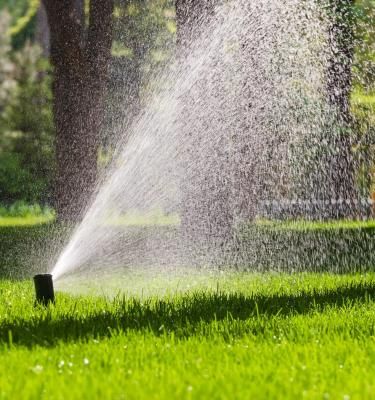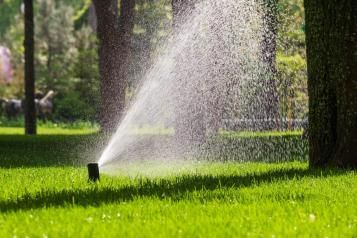
When Rain is Not Enough. Tip #4 Watering Wisely
Just like us, your lawn deserves a refreshing sip to keep hydrated. It’s something we feel nature should do for us. And yes, at some times of the year, rainfall will be enough to give your lawn the moisture it needs, but at other times a parched lawn is just a step away from turning into a desert. So, keep it green, keep it seen, keep it feeling a barefoot dream!
Watering wisely is not as hard as you think. Most of us will think to water grass when the lawn looks yellow or discoloured, or has dry and crusty leaves, but you can catch it before it gets to this stage. A good trick for checking if your grass needs watering is to do a “footprint test”. If your footstep leaves a noticeable indent in the lawn, it needs watering. If the grass springs back, it doesn’t need to be watered.

The best time to water grass
Answering the ‘when to water’ question is easy. As a general rule, the best time to water your lawn is between 6am and 10am (the earlier the better). Mornings tend to be cooler and less windy, meaning water is slower to evaporate. Less evaporation gives the water a chance to soak into your lawn and reach the lawn roots more effectively. This is advised over watering at night because night watering can lead to fungal problems.
How often to water your lawn
How often should I water my grass, you ask? How often to water requires you to consider a few factors - your location, type of grass, and season. Most Australian lawns are warm season grasses like Buffalo, Kikuyu, Couch and Zoysia. Warm season grasses tend to be better suited to Australia’s climate.
- In winter: Water only if needed. Some may not need watering unless there is an extended dry spell.
- In autumn/spring: Once a week is a good guide. If you feel there’s been a decent amount of rain, once a fortnight. Don’t worry, you don’t need to live your life constantly checking the weather app! However, be wary. Water too often, and you risk encouraging shallow roots and fungal disease.
- In summer: Every three to four days, especially when the weather is hot and dry. In summer if don’t water enough, your lawn is likely to discolour, get patchy, or die entirely.
How long to water grass
How long to water for? Generally, 20 to 30 minutes of watering with a sprinkler system is a good guide. Water less frequently but make sure you water deeply. This promotes deep roots and trains your grass to be more drought tolerant. Watering frequently and lightly promotes shallow roots that can more easily get stressed by heat and drought.
For those who want to get technical, how long to water your grass comes down to how much water grass needs. You want the soil to be wet to a depth of 150mm. This generally takes 20 to 30 minutes of watering with a sprinkler system. You can check the watering depth by sinking a shovel or screwdriver into your lawn or digging a small hole to check the soil.
Another way to keep track of this is to place an ice-cream container on your lawn before you start watering. Once the water in the container reaches a depth of 10mm to 15mm, you’ve watered enough, and the idea here is that 10 to 15mm of water should penetrate the soil to a depth of about 150mm.
Lastly, check for water restrictions in your area. Each state or territory has different water restrictions so make sure to check the rules in your area. The Bureau of Meteorology provides access to current water restrictions information for the whole of Australia.
And remember a well-maintained and healthy lawn improves air quality, prevents soil erosion, and actually minimises the amount of water you need to use overall. Healthy grass is stronger, more resistant to weather conditions and requires less frequent watering compared to a ho-hum lawn.
FAQs
How much should you water a new lawn?
For newly laid turf, water every day for the first two weeks, then slowly reduce the frequency over the next three to four weeks. In extreme heat, water three to five times a day. By week six, you should be watering about every second or third day. Once the lawn is established, you can drop to a more regular schedule, however, a new lawn will require more frequent watering in its first summer.
How can you bring back dead grass?
Even the gardening magicians at Love the Garden can’t bring back completely dead grass. But there are ways to revive dying grass. For dormant and dying grass, avoid mowing, limit foot traffic, remove weeds by hand, and water the grass thoroughly. If your grass is truly dead, you’ll need to replace it entirely by reseeding or laying fresh turf.
How often should you water your lawn in summer?
How often you need to water the lawn in summer depends on the climate and the type of grass you have. For warm-weather grasses, such as Couch, Buffalo and Kikuyu, water every three to four days. For cool season grasses, such as Bluegrass and Ryegrass, water every day.
How long should you leave sprinklers on?
To encourage the roots of grasses to grow deep and be more drought-resistant, the soil should be moist to a depth of about 150mm. We recommend running your sprinklers for about 20 to 30 minutes each time you water to achieve this result.
What is the most effective way to water your lawn?
Irrigation systems such as sprinklers, or soaker hoses distribute water more evenly that hand-watering. Pair your irrigation system with a wetting agent to help your lawn absorb water more efficiently.
Do you still need to water your lawn if it's been raining?
No. Usually, rainfall will be enough to give you lawn the moisture it needs. Keep an eye on upcoming weather events to make sure you’re making the most of the rain not overwatering your lawn.
What temperature is too hot to water grass?
Avoid watering your lawn when the temperature is over 30 degrees Celsius. The best time of day to water grass when it’s hot is before 10am when temperatures are at their lowest. This will help limit evaporation.








